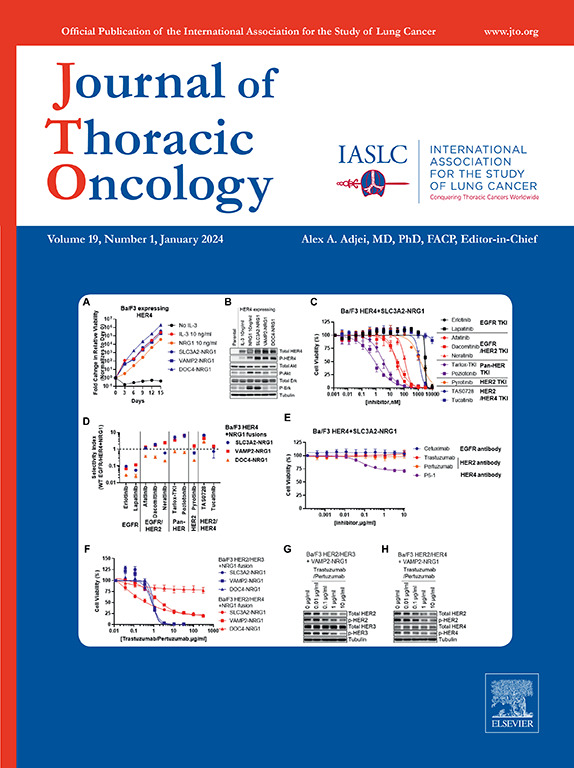Neoadjuvant and Adjuvant Osimertinib in Stage IA to IIIA, EGFR-Mutant NSCLC (NORA)
IF 21
1区 医学
Q1 ONCOLOGY
引用次数: 0
Abstract
Introduction
Treatment with adjuvant osimertinib for three years is the standard-of-care for resected stage IB to IIIA NSCLC harboring EGFR mutations. The role of neoadjuvant osimertinib in the perioperative setting is yet to be elucidated in the NeoADAURA study (NCT04351555).
Methods
This is a single-center, pilot study of patients with clinical stage IA to IIIA NSCLC (American Joint Committee on Cancer eighth edition) harboring an activating EGFR mutation (Exon 19 deletion, L858R) (NCT04816838). Patients were treated with two 28-day cycles of neoadjuvant osimertinib followed by surgical resection and three years of adjuvant osimertinib. The primary endpoint was the objective response rate after two cycles of neoadjuvant treatment. Secondary endpoints included the pathologic complete response rate and major pathologic response rate. Exploratory objectives included the correlation of longitudinal circulating tumor DNA testing (Signatera) and response to neoadjuvant osimertinib.
Results
A total of 25 patients were enrolled and treated with neoadjuvant osimertinib, and all patients received surgical resection with R0 resection. The objective response rate was 44% (n = 11) all of which were partial responses. Fourteen patients (56%) reported stable disease after neoadjuvant osimertinib. The major pathologic response and pathologic complete response rates were 24% (n = 6) and 0%, respectively. None of the patients received adjuvant chemotherapy. The median disease-free survival was not reached at a median follow-up of 31 months (range: 13.8–38.6 mo). Six patients (30%) were circulating tumor DNA–positive at baseline and achieved clearance after 1 cycle of neoadjuvant osimertinib. There were no grade 3 adverse events during neoadjuvant treatment.
Conclusions
Two cycles of neoadjuvant osimertinib did not meet its primary endpoint of ORR. Neoadjuvant osimertinib is a feasible approach with a manageable safety profile in resectable EGFR-mutant NSCLC.
新辅助和辅助奥西替尼治疗IA-IIIA期egfr突变型非小细胞肺癌(NORA)。
导读:奥希替尼辅助治疗3年是切除了表皮生长因子受体(EGFR)突变的IB-IIIA期非小细胞肺癌(NSCLC)的标准治疗方案。新辅助奥希替尼在围手术期的作用尚未在NeoADAURA研究(NCT04351555)中得到阐明。方法:这是一项单中心的试点研究,研究对象是含有EGFR激活突变(外显子19缺失,L858R) (NCT04816838)的临床期IA-IIIA NSCLC (AJCC第8版)患者。患者接受两个28天周期的新辅助奥希替尼治疗,随后进行手术切除和3年的辅助奥希替尼治疗。主要终点是新辅助治疗2个周期后的客观缓解率(ORR)。次要终点包括病理完全缓解率(pCR)和主要病理缓解率(MPR)。探索目标包括纵向循环肿瘤DNA (ctDNA)检测(Signatera)与新辅助奥希替尼应答的相关性。结果:共纳入25例患者,采用新辅助奥希替尼治疗,所有患者均行手术切除,R0切除。ORR为44% (n=11),均为部分反应。14例(56%)患者在新辅助奥希替尼治疗后病情稳定(SD)。MPR和PCR检出率分别为24% (n=6)和0%。所有患者均未接受辅助化疗。中位无病生存期(DFS)未达到中位随访31个月(范围13.8-38.6个月)。6名患者(30%)在基线时ctdna呈阳性,并在新辅助奥希替尼治疗1个周期后获得清除。新辅助治疗期间无3级不良事件(ae)。结论:两个周期的新辅助奥希替尼治疗未达到ORR的主要终点。对于可切除的egfr突变型NSCLC,新辅助奥希替尼是一种可行的方法,具有可控的安全性。
本文章由计算机程序翻译,如有差异,请以英文原文为准。
求助全文
约1分钟内获得全文
求助全文
来源期刊

Journal of Thoracic Oncology
医学-呼吸系统
CiteScore
36.00
自引率
3.90%
发文量
1406
审稿时长
13 days
期刊介绍:
Journal of Thoracic Oncology (JTO), the official journal of the International Association for the Study of Lung Cancer,is the primary educational and informational publication for topics relevant to the prevention, detection, diagnosis, and treatment of all thoracic malignancies.The readship includes epidemiologists, medical oncologists, radiation oncologists, thoracic surgeons, pulmonologists, radiologists, pathologists, nuclear medicine physicians, and research scientists with a special interest in thoracic oncology.
 求助内容:
求助内容: 应助结果提醒方式:
应助结果提醒方式:


